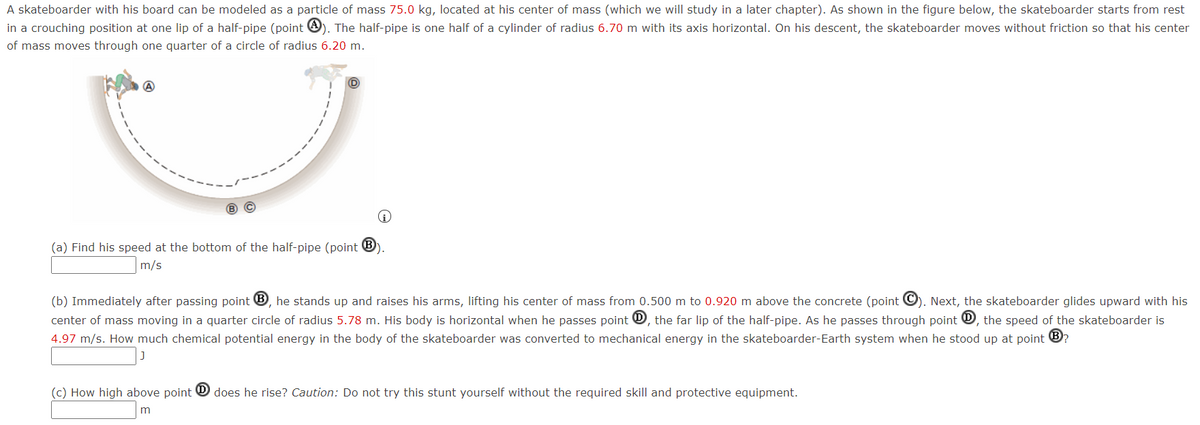A skateboarder with his board can be modeled as a particle of mass 75.0 kg, located at his center of mass (which we will study in a later chapter). As shown in the figure below, the skateboarder starts from rest in a crouching position at one lip of a half-pipe (point O). The half-pipe is one half of a cylinder of radius 6.70 m with its axis horizontal. On his descent, the skateboarder moves without friction so that his center of mass moves through one quarter of a circle of radius 6.20 m.
A skateboarder with his board can be modeled as a particle of mass 75.0 kg, located at his center of mass (which we will study in a later chapter). As shown in the figure below, the skateboarder starts from rest in a crouching position at one lip of a half-pipe (point O). The half-pipe is one half of a cylinder of radius 6.70 m with its axis horizontal. On his descent, the skateboarder moves without friction so that his center of mass moves through one quarter of a circle of radius 6.20 m.
Principles of Physics: A Calculus-Based Text
5th Edition
ISBN:9781133104261
Author:Raymond A. Serway, John W. Jewett
Publisher:Raymond A. Serway, John W. Jewett
Chapter7: Conservation Of Energy
Section: Chapter Questions
Problem 49P
Related questions
Question
Question in pic.

Transcribed Image Text:A skateboarder with his board can be modeled as a particle of mass 75.0 kg, located at his center of mass (which we will study in a later chapter). As shown in the figure below, the skateboarder starts from rest
in a crouching position at one lip of a half-pipe (point O). The half-pipe is one half of a cylinder of radius 6.70 m with its axis horizontal. On his descent, the skateboarder moves without friction so that his center
of mass moves through one quarter of a circle of radius 6.20 m.
(D
(a) Find his speed at the bottom of the half-pipe (point ®
m/s
(b) Immediately after passing point ®, he stands up and raises his arms, lifting his center of mass from 0.500 m to 0.920 m above the concrete (point ©). Next, the skateboarder glides upward with his
center of mass moving in a quarter circle of radius 5.78 m. His body is horizontal when he passes point O, the far lip of the half-pipe. As he passes through point O, the speed of the skateboarder is
4.97 m/s. How much chemical potential energy in the body of the skateboarder was converted to mechanical energy in the skateboarder-Earth system when he stood up at point ®?
(c) How high above point
does he rise? Caution: Do not try this stunt yourself without the required skill and protective equipment.
Expert Solution
This question has been solved!
Explore an expertly crafted, step-by-step solution for a thorough understanding of key concepts.
This is a popular solution!
Trending now
This is a popular solution!
Step by step
Solved in 4 steps

Knowledge Booster
Learn more about
Need a deep-dive on the concept behind this application? Look no further. Learn more about this topic, physics and related others by exploring similar questions and additional content below.Recommended textbooks for you

Principles of Physics: A Calculus-Based Text
Physics
ISBN:
9781133104261
Author:
Raymond A. Serway, John W. Jewett
Publisher:
Cengage Learning

Classical Dynamics of Particles and Systems
Physics
ISBN:
9780534408961
Author:
Stephen T. Thornton, Jerry B. Marion
Publisher:
Cengage Learning

University Physics Volume 1
Physics
ISBN:
9781938168277
Author:
William Moebs, Samuel J. Ling, Jeff Sanny
Publisher:
OpenStax - Rice University

Principles of Physics: A Calculus-Based Text
Physics
ISBN:
9781133104261
Author:
Raymond A. Serway, John W. Jewett
Publisher:
Cengage Learning

Classical Dynamics of Particles and Systems
Physics
ISBN:
9780534408961
Author:
Stephen T. Thornton, Jerry B. Marion
Publisher:
Cengage Learning

University Physics Volume 1
Physics
ISBN:
9781938168277
Author:
William Moebs, Samuel J. Ling, Jeff Sanny
Publisher:
OpenStax - Rice University